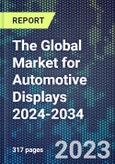Automotive display technologies are becoming increasingly important in modern vehicles. They are the key interface for the interaction between the driver and the vehicle, and are also used for entertainment purposes. Automotive display manufacturers have seen significant increase in order volumes of late and vehicle-mounted displays are expected to serve a broader role beyond displaying screen images as electronic technology advances, particularly with the rise of electric vehicles (EVs) and autonomous driving.
The Global Market for Automotive Displays 2024-2034 covers the latest display technologies for automotive applications including LCD, OLED, TFT-LCD, TFEL, HUD, 3D, CGH, LFD, SLM, flexible, transparent, curved, quantum dot, electrophoretic, electrochromic, plasmonic displays, smart glass, and metamaterials.
Key market areas covered include infotainment systems, instrument clusters, head-up displays, ADAS, autonomous driving, smart mirrors, mini-LEDs, and micro-LEDs. The trends, benefits, limitations, and companies developing each display type are examined.
Contents include:
- Market trends, drivers and challenges.
- In-depth analysis and market outlook of display technologies for Automotive including:
- LCD (Liquid Crystal Display).
- OLED (Organic Light Emitting Diode).
- TFT-LCD (Thin Film Transistor LCD).
- Thin-film electroluminescent (TFEL) displays.
- Head-Up Displays (HUDs).
- 3D displays.
- Computer-Generated Holography (CGH).
- Light Field Displays (LFD).
- Spatial Light Modulators (SLM).
- Flexible displays.
- Transparent displays.
- Curved displays.
- Infotainment systems.
- Display Technologies for IVI Systems.
- Cluster displays.
- ADAS and autonomous driving displays.
- Smart mirrors and pillar displays.
- Smart glass.
- Mini-LED displays.
- Micro-LED displays.
- Quantum dot displays.
- Electrophoretic displays.
- Electrochromic displays.
- Plasmonic displays.
- Heads-up contact lens.
- Metamaterials.
- Global market revenues 2018-2034, by display type and technology. Regional analysis also provided.
- Profiles of 62 companies. Companies profiled include Continental, Envisics, Hyundai Mobis, LG Display, Samsung Display, TCL, Visteon and WayRay.
This product will be delivered within 1-3 business days.
Table of Contents
1 RESEARCH METHODOLOGY
Companies Mentioned (Partial List)
A selection of companies mentioned in this report includes, but is not limited to:
- AGC, Inc.
- AlphaMicron, Inc.
- Audi AG
- AUO
- AU Optronics Corporation
- BMW
- BOE Technology Group Co., Ltd.
- Bosch
- Brightview Technologies
- Ceres Holographics
- Continental
- Digilens
- DMDisplay Co., Ltd.
- Epileds Technologies
- Ennostar, Inc.
- Envisics
- Epileds Technologies
- Everlight Electronics Co., Ltd.
- Excyton
- FlexEnable Limited
- Futaba Corporation
- Futurus
- GARMIN
- Gauzy Ltd.
- GM
- HCP Technology HCP Co., Ltd.
- Hitachi Chemical Company Ltd.
- HOLOEYE Photonics AG
- HUDWAY
- Hyundai Mobis
- iGlass Pty Ltd
- Innolux
- Industrial Technology Research Institute (ITRI)
- Inuru GmbH
- Japan Display, Inc.
- Joled Inc.
- Leia Inc
- LG Display
- Lextar Electronics
- Lumineq
- Luminit, LLC
- Merck KGaA
- Nichia Corporation
- Novares
- Osram
- PlayNitride, Inc.
- Qualcomm
- Rohinni LLC
- Samsung Displays
- Seoul Semiconductor/Seoul Viosys Co., Ltd.
- Shantou GoWorld Display
- SMK Corporation
- Spectralics
- Stellantis
- Synaptics Inc.
- TCL
- Tianma Microelectronics Co., Ltd.
- Unity Opto Technology Co., Ltd
- Valeo
- Visteon
- WayRay
- XPeng
Methodology

LOADING...








